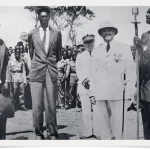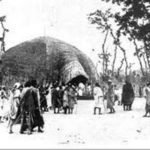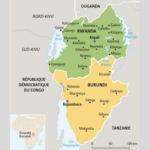The Clientage System, “Ubuhake”
In the beginning of this chapter we have already introduced the institution of clientage called ubuhake, denoting the relationship between garagu (client.) and shebuja (patron). This relationship was initiated by the person in the inferior position. Before a patron would accept somebody as his client, the person seeking this relationship had to serve a time of apprenticeship lasting from six months to two years. Baring that time he was called umuhange. At the end of that period, the patron would let his future client know that he accepted him as a client. The client would assemble with his family in the homestead of the patron and in the presence of witnesses or other clients of the patron, the client would, with one knee on the ground, place his hands, palms together, in the open hands of the patron and say something like “I shall be forever faithful to you’. The patron would then give him a cow in usufruct and thus the agreement was sealed.
The ubuhake relationship was perpetuated between the heirs of patron and client, subject to the approval of the patron.
In material terms the client had the full usufruct of the cow’s products including the meat and skin when she died.
Male increase became the client’s private property while female increase remained the patron’s although the client had full usufruct of the female increase. The client hadthe right however to use the ubuhake cow or its calf for bride price and in this case the patron could not reclaim it for whatever reason, even if the ubuhake agreement ended.
In that case it was completely lost to the patron because it had become “imbata” of the bride’s lineage. The cow could be used again by the client to become the patron of somebody else. Further the ubuhake agreement extended to all kinds of other material advantages for the client resulting from the patron’s position as his protector and benefactor. The client in need of a hoe or clothing, additional supplies for a feast or meat and milk for a sick person, would ask his patron who was expected to give whatever was needed. In practice such gifts depended mainly on the strength of the relationship which had been built up, which was related to the client’s support of his patron.
If the client’s widow or children were not taken care of the patron would do this. In later years it was the patron who paid the poll-tax imposed under Belgian rule. Moreover the patron was supposed to support and help the client in all contexts and when a client had committed an offence the patron was expected to help or even pay the whole of the fineor the compensation. In these contexts the patron would accompany his client, he himself surrounded by all his clients.
In case the client was murdered, it was the patron who demanded justice from the Mwami. All these instances of help or protection of the patron must be seen not as part of a prearranged detailed agreement but as an expected consequence and part of the relationship.
The client on the other hand had to support his patron. The nature of this support is related to the particular needs of the patron and the capabilities of the clientas in the client’s case, we can distinguish two kinds of obligations, one of which is expressed in economic terms and one which refers to the field of power.- In economic terms the client, if he was an agriculturalist, would help in cultivating the patron’s field or provide him with some of the products of his own fields, collect firewood and act as night-watch.
If the client was a cattle owner himself he would be required to help in milking, herding, accompanying the patron on his travels, etc. Moreover the patron had the right of umurundo, that is to say that once in his lifetime he could review all the cattle of his client and choose one of them for his own private property. Imbata cattle were excluded from this. The extent of the support demanded was related to the status of the client as this status was part and parcel of the relationship between the two partners.
The higher the status of the client the more support he could expect in case of need. Neither the type or frequency of labour nor the type and quantity of goods were pre-arranged in the agreement, it all depended on the support which the patron needed just as the support the patron gave depended on the needs of the client.
There were special sanctions against excessive demands from either side. Moreover this was contrary to the essence of the agreement since it was opposed to the “moral” support which was part of the relationship. Moreover in the subsistence economy, which lacked external markets andstoring techniques, hoarding of agricultural products was impossible and in no way profitable. Although economic benefits definitely entered into the agreement on both sides, the ubuhake from the patron’s point of view was primarily apersonal relationship in which he could count on the loyalty of his clients, who were bound to him more closely than to anyone else outside his immediate kin. Therefore no client could have two patrons, even if materially he could afford to satisfy both their needs. Moreover in effectively protecting his clients the patron had an opportunity to show and to test his strength. The support of his clients was not only of importance to the patron in court cases but had special relevance in the competition for and the protection against political power. In this, he depended on a wider circle of relationships than could be relied on through kinship.
The patron could be a sufficiently wealthy private citizen, who wanted to prove his status. Often, however, the patron was a political chief and all political chiefs were patrons. Office, as we have seen, while describing land tenure, gave his access to cattle (e.g. ibikingi). These cattle he could and did use partly to build up his own herd and partly to establish relationships with clients. The ability to strike the right balance was not unrelatedto being a suceessful chief. In the political structure cattle were passed up the social scale and in the ubuhake structure cattle were passed down but with the reservation that in a downward transfer ultimate control rested with the patron who kept the property rights over his cattle. In more than one sense the ubuhake system is related to and conditioned by the political structure although it is not a direct part of it. Although one’s patron could be one’s political chief the nature of the ubuhake relationship, including the way it was entered and maintained, was essentially different from the relationship between chief and subject. Ubuhake relationship, contrary to the chief-subject relationship, could be ended by either of the parties concerned. If the relationship was ended by the patron because the client did not fulfil his obligations, the patron would sue his client for damages. The client, being without a patron, would then be in a highly vulnerable position. However it was normally a stable relationshipwhich if it was ended resulted in the patron taking his cattle back. Since 1920 however, when political chiefs andeven other patrons broke off their ubuhake relationship, thepatron would take all the client’s cattle, including his private imbata cattle:
“Administrative chiefs who were important lords are said….to have modified the custom to their own advantage by establishing the principle of merging cows received from a lord with those acquired independently of any shebuja” (Maquet I96I p.132)
In this context it is however important to note that clients cannot be identified with Hutu, since both Tutsi and Hutu were clients in the ubuhake system. Neither did being a client of one person exclude the same person from being patron to another. Categorisation as to clients and patrons cannot therefore be used as a basis of stratification of Rwanda society. Neither was the fact of being a patron or a client necessarily an index of higher or lower rank in that society. Respective rank depended less on the status of patron or client than on the actual social ranking of the person who was one’s patron or the persons who were one’s clients. The actual status of a patron depended also on the number of his clients. Nevertheless being a client but not a patron denoted a lower status in the system of distribution of power and authority than being both a clientand a patron.
Ubuhake is therefore an interpersonal and normally hereditary relationship. It was freely entered into bytwo partners of unequal status and resulted in mutual support in matters relating to ’politics’ and power. In its formation the patron gave a cow to the client as a proof and external sign of the relationship and as a part of the exchange of economic benefits in goods and services which differed in kind as between patron and client. Essentially therefore the relationship between patron and client is one of mutual advantage.
In Rwanda political power rested with the king who delegated his power to more or leas close affines and traditionally important lineages. within these lineages struggle and competition went on for the actual holding of power positions. Support in this contest could not be limited to the lineage as, firstly, in central Rwanda the lineages were not localised. Secondly, competition went on within the lineages and, thirdly, actual power not onlyextended over but involved the support of a wider group than the lineage. This meant in practical terms that official authority extended not only over pasturalists but also over agriculturalists, the persons in these two occupational categories being dispersed over the area of a chiefdom. Those chiefs who remained sedentary had anevident advantage in the complex manipulation of supportnecessary in the Rwanda political system. By sharing outhis cattle, the chief obtained a following on a local and not necessarily kinship basis, although it was possible to have close kin, e.g. siblings as clients. He also obtained the agricultural products he needed. Others having cattle and aspiring to political power also profited from becoming sedentary so that they could build up their following and assure agrarian products through sharing out their cattlein the ubuhake system.
In both cases sharing out of cattle and support from the clients is clearly related to obtaining or maintaining political office. Other cattle owners who remained sedentary for whatever reason rather than being semi-nomadic, were necessarily drawn into the competition for power, through the need to protect their cattle from those who wanted them as an instrument to build up a following.
This protection they had to obtain by becoming clients of the political chief, that is by receiving a cow from the chief in exchange for their support. This I will call primary clientage. The client could again establish his own client relationship with the same cow. This I will call secondary clientage.
The more widely a man managed to extend his own circle of clients the more support he would have in the locality.
Moreover his own patron would benefit from this support and therefore he would receive in turn greater support and protection, from his own patron. Thus the small cattle owner was almost unavoidably drawn into the power struggle and power structure and felt that he played an important role in distributing his own and his clients allegiances.
From the point of view of political support it was evidently more profitable to bestow cows through ubuhake on those who were already cattle owners and likely contenders in the political competition since it was these men who would be likely to hand on the cows in creating secondary clientage relationships and thereby build up support for the original owner. If a cow was given to an agriculturalist or, more generally, to a non-contender in the power struggle he would be more likely to keep the cow for his own use and not extendthe circle of clients through secondary clientage relationships. Thus the clientage system worked in favour of the cattle owners as they could rely on preferential treatment.
Those who had cattle, but did not participate in the political struggle, protected their cattle by leading a seminomadic life and did not have clients. It is in this context that we should see the semi-nomadic owners ofextensive herds in Eastern Rwanda, the Hima. Againstthis background we must see also the relationship of patronand client in as far as it enters the political field. Itis a relationship of mutual advantage, but containingadvantages of a different kind for patron and client andin the case of primary and secondary clientship. In thecase of primary clientship cattle, from the point of viewof the patron or chief, were an instrument for obtainingor maintaining power which was related to the fact thathe had no coercive power at his disposal. From the pointof view of the client, cattle were an instrument ofprotection and of obtaining power. In the case of secondary clientship, cattle were, from the point of view of both patron and client, a means of protection against abuse of political power. But in both cases obtaining or maintaining power and protection against that power depended on the support which the patron obtained. It was a two way street.
The ubuhake system was interrelated with the political structure just as the political structure was interrelated and partly depended on the ubuhake system, but this interdependence was effective mainly because the systems werenot identical. Mobility within the political structure made the working of the ubuhake system possible. As soonas the mobility within the political system was no longeroperative the ubuhake would lose its fundamental meaning
of inter-dependence, as holding office would no longer depend on the support gained through clientage. It would become a one way street. This is exactly what happened in the years of colonial rule.
To this must be added that the chief had from then on not only coercive force at his disposal but also that the checks and brakes operative through the army structure and the function of the army chief were no longer a part of the social system. Because of the ubuhake system, the ruled participated in the power structure and this made for integration, which was of special importance since chiefs did not have any institutionalised councils. Through the ubuhake system the cattle owning lineages who were in the power-holding group could control the instrument of power and through the institution of primary and secondary clientage eliminate the smaller cattle owners while allowing them a limited part within the power structure. In doing so theykept them within but not an effective part of the structure.
Ubuhake system also served as a channel for the distribution of wealth and a means for the exchange of specialized labour. Although ultimate control of cattle remained with the patron in primary clientage and to a lesser degree in secondary clientage, cattle, as we have seen, wasonly a part, although an important part, of the material goods which were transferred from patron to client. Political office was a way of obtaining cattle which were redistributed among the supporters, without the patron losing Control, except in the case of cattle used for bridewealth by the client. The amount of material support for the cattle owning patron must be seen in relation to his diet, which was largely limited to dairy products, to the number of clients which the patron had and to the fact that a surplus of agrarian products could not either be stored for long, sold or exchanged. The normal amount of services demanded and given by the client were limited by these factors.
Moreover in traditional Rwanda society the army chief provided an important means of protection against possible abuse. The inherent weakness of the system in which the patron would protect his clients against outsiders, was that within the ubuhake system itself the client had nobody to avenge him against an unreasonable patron.
Breaking off the relationship was possible but left the client in a very vulnerable position. The main sanction against abuse was thus the patron’s own dependence on his client’s support and the client’s possibility of appeal to and protection of the army chief. To prevent his private cattle (imbata) being taken by the patron when the client broke off the ubuhake relationship, the client could place them under the protection of the army chief. However both these checks disappeared from traditional Rwanda society after the impact of colonial rule. Firstly, there was no longer need for support from below either to obtain or maintain office nor for the implementation of the chief’s orders as he now had coercive power at his disposal. On the other hand, the need of clients for protection remained and even increased due to greater competition for available resources resulting from population increase following the new health measures, control over famine and the cessation of warfare.
Moreover with the introduction of a money economy labour and agrarian products could be converted into cash which was both non-perishable and which opened up new avenues for spending.
Secondly, the army structure and the function of the army chief had been abolished, thus removing another check on possible abuse.




